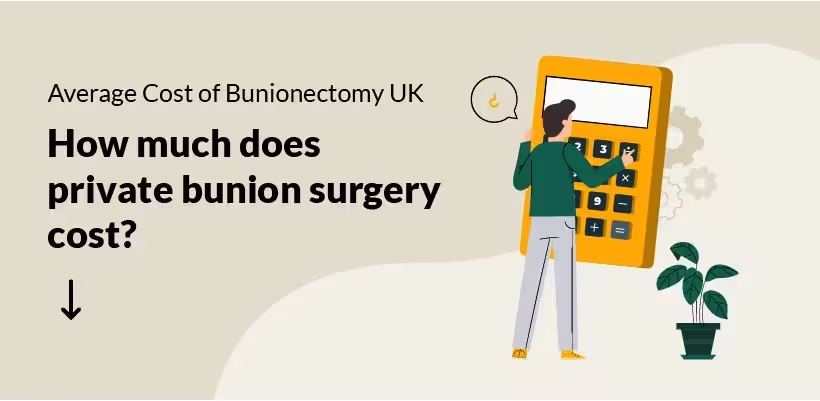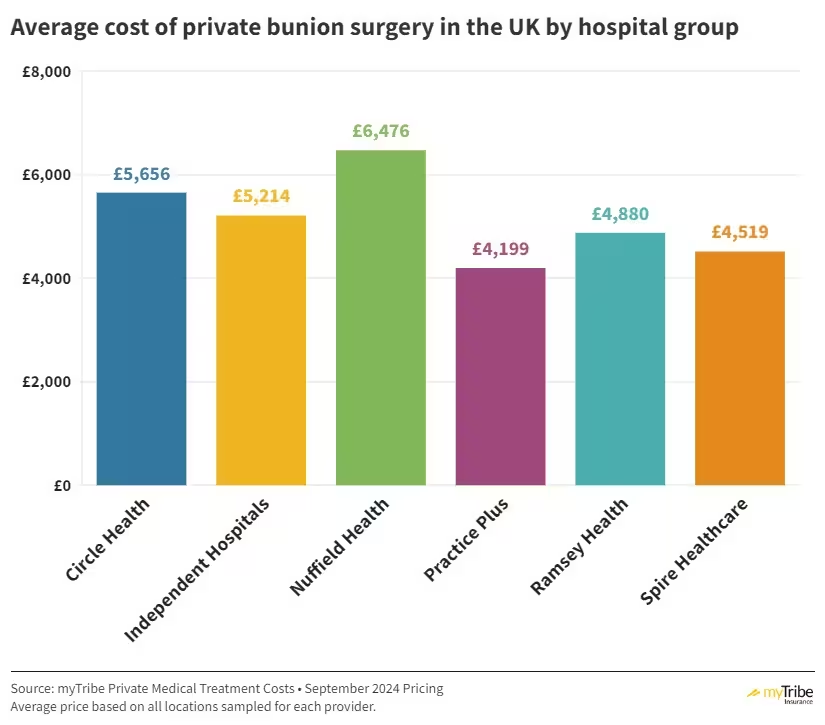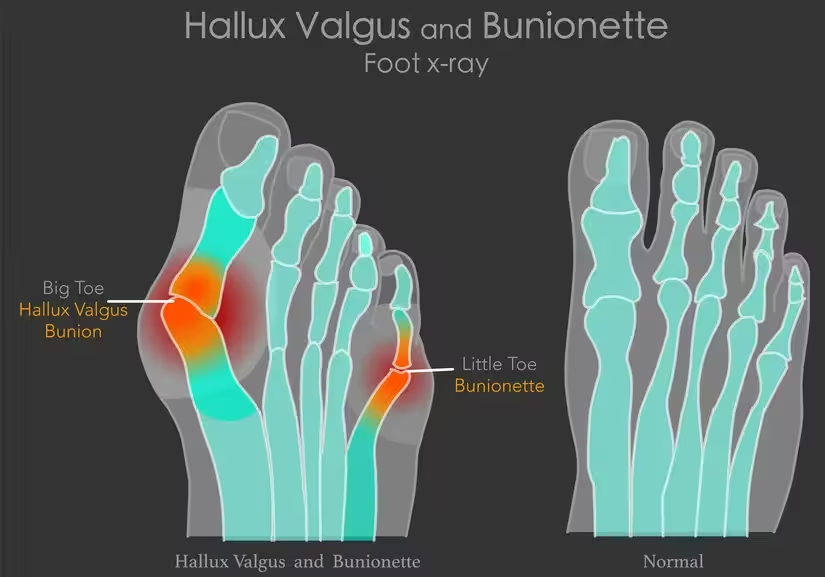The average cost of private bunion surgery in the UK (2025)
Bunions affect your big toe, causing deformity, pain, and difficulty walking, which can seriously impact your daily life and activities. If your doctor recommends surgery, you might consider going private. Our guide lets you know what to expect from bunion surgery and shares our research into the average price of having it done in a private hospital.
Stuck on a waiting list and looking for treatment?
What is a bunion and when might you need surgery?
A bunion is a deformity where the big toe moves out of place and bends towards the other toes, causing the foot to widen and the big toe joint to become more prominent. The symptoms include pain, swelling and redness, hard lumps and swollen skin.
Bunions can be hereditary or occur because of arthritis or other medical conditions. They can also happen if you wear shoes that don't fit properly. Your doctor will likely recommend non-surgical treatment initially, such as wearing wide-fitting shoes, insoles or toe splints. Losing weight and taking painkillers can help with pain relief. Your doctor might also use steroid injections to reduce inflammation. If these treatments don't help, you may need surgery.
You can have bunion removal surgery via the NHS, but there are advantages to choosing private treatment. We consider some of the main benefits of private bunion surgery.

In September 2024, our private healthcare researchers obtained prices from 38 private hospitals around the UK and found that the average cost of private bunion surgery (unilateral) is currently £5,260.
The average cost is based on numerous factors, and you could pay more or less for bunion surgery.
The most expensive price we received was found in London, with the London Clinic used by the Royal Family, quoting prices from £7,645. The least costly was Blakelands Hospital, part of the Ramsay Health Care group, where a private bunionectomy costs just £3,035.
While a highly qualified consultant will perform your bunion surgery, the rate they charge will impact the cost. Prices will typically rise as surgeon gain experience and increase their expertise with further training.
You can learn more about the factors affecting private surgery costs in the UK here.
Your chosen hospital's location is one of the most significant factors impacting private surgery costs, as it affects rent and staffing costs. When choosing a private hospital, it's worth comparing quotes from several hospitals around your preferred location to get the best deal.
The table below details the average cost of a private bunionectomy in the twelve regions of the UK.
Surprisingly, prices in the north of England and Scotland were particularly high, with a private bunionectomy costing on average £6,776 in Yorkshire and the Humber, £6,265 in North East England and £5,503 in Scotland.
Usually, we'd expect to see London at the top; however, with an average cost of £5.784, it's only a touch more than in Scotland, making London the third most expensive region for a bunionectomy.
Prices for a private bunionectomy were lowest in Wales, where the average cost was £4,492, followed by Southeast England at £4,604, then Northern Ireland at £4,545 and finally, the East midlands at £4,619.
Our research looked at bunionectomy prices at 38 private hospitals scattered across the UK, but many are part of a larger group of hospitals, namely Circle Health, Nuffield Health, Practice Plus Group, Ramsay Health and Spire Healthcare, alongside a handful of independent private hospitals.
The graphic below shows the average cost of private bunion surgery by private hospital group, with the independents grouped. Please bear in mind that most of these hospital groups charge different amounts at different hospitals, so, for example, if you approached the Spire hospital close to you, you may find that the price of your treatment is less or more than what's shown below.

Now we've given you an idea of the potential cost of your private bunion surgery, you might be wondering whether you can afford to pay for private treatment. There are three main ways to pay, and your circumstances will influence which one is the right choice for you.
Related articles:
- What is private health insurance?
- Best private health insurance companies
- How much does private health insurance cost in the UK?
Here's what you can expect from your bunion surgery.
Before your surgery
Your chosen hospital will contact you before your surgical procedure to let you know how to prepare for surgery. NHS providers typically recommend giving up smoking before surgery, particularly if your bunion surgery involves a bone or joint fusion. Smoking can reduce the blood flow to your feet, increasing the risk of infection and preventing your wound from healing. Your surgeon will take a full medical history during your initial consultation. This will include asking whether you smoke and taking details of any medication you take regularly.
You'll usually need to wash your feet, cut your toenails and remove nail varnish if you wear it.
You can also expect to fast before your operation to minimise the risks associated with anaesthetic. Your consultant will let you know when to stop eating and drinking before your operation.
Preparing for your recovery before you go into hospital is also a good idea. This could include organising care, arranging time off work, and rearranging your home to minimise hazards and ensure everything is within reach.
The surgery
Bunion surgery varies depending on whether you have traditional or keyhole bunion surgery. In a standard osteotomy, your surgeon will cut into the bunion, open your big toe joint and remove the bony bump. They'll also cut through the first metatarsal (the main bones in your foot) to reposition it and fix it with screws. Your surgeon will also tighten the tissues on the other side of your foot to correct the deformity.
Bunion surgery is usually done under local anaesthesia, where you stay awake during your operation. However, surgeons sometimes use general anaesthesia; they'll discuss the best option for you before your surgery.

Aftercare in hospital
Most surgical procedures to remove bunions are done in a day case unit, so you can go home after the operation as long as you're medically well and have someone who can stay to keep an eye on you after your operation.
If you don't have anyone to look after you, or if you have a medical condition such as asthma, high blood pressure or diabetes, your surgeon will likely recommend you have an overnight stay in the hospital so they can monitor you. Sometimes, you might need to stay overnight because you're in pain and need extra pain relief.
While you're still in hospital, staff will sort out your pain medication, and a physiotherapist will usually come to get you moving and show you how to use crutches to keep the weight off your foot while you recover.
Recovering at home
After bunion surgery, you'll have dressings on your foot and usually need a protective shoe or sandal. However, most people don't need a plaster cast. When you go home, you should avoid walking and put your feet up as much as possible. Your medical team will advise you on walking and moving your foot to reduce swelling and help your foot heal. You'll usually have a post-operative check a few weeks after surgery when your toe will be in a splint. As your wound heals, you can walk more, still using crutches and the protective shoe, until after your final check-up.
Post-operative symptoms
As with any operation, you can expect to have some side effects after bunion surgery. Your foot and big toe will likely be sore, so you may need painkillers. You'll also have some swelling in your foot, which is why you need to keep your foot up as much as possible for the first two weeks. If you develop severe pain in your foot, contact the hospital, as this can indicate a problem.
Scar tissue can cause stiffness in your toe. About six weeks after surgery, when you can start exercising more, moving and stretching your toe can help to reduce stiffness and prevent it from becoming permanent.
You'll have follow-up checks with your surgeon and medical team so you can speak to them if you have any worrying symptoms or are concerned with any aspect of your recovery.
Possible complications
All surgical procedures carry some risk; your doctor will take steps and give you advice to minimise these. Infection in the wound is a common risk, so good hygiene is essential. Some patients develop post-operative chronic regional pain syndrome, which can cause pain in the affected area or other parts of the body. There's also a risk of blood clots.
Some specific risks are associated with bunion surgery, including continuing stiffness or weakness in the big toe joint. Sometimes, the big toe can tilt back into its original position, causing another bunion that could need further surgery.
You can reduce your risk level by following your consultant's advice and staying healthy by giving up smoking and increasing your activity levels when it's safe to do so. Some foot conditions are relieved by losing weight, so eating well and staying active can help prevent your bunion from reoccurring.
Going back to work
You'll likely need to take some time off work during recovery, but the amount of time off you need will depend on your circumstances. The type of work you do and how much time you spend standing or sitting will affect your absence period.
The way you travel to work is also important as you'll need to avoid driving initially and may not be able to walk or stand for long enough to use public transport. However, if you work from home or can get a lift to the office, this can help you return to work sooner.
Driving
You'll usually need to avoid driving while wearing the splint. Your toes and feet mustn't be too stiff. It's a good idea to build up gradually and check you can safely execute an emergency stop. It can affect your insurance coverage if you start driving too early and get into an accident.
Getting active
If you're active or regularly play sports, you'll need to build up slowly after your bunion surgery. Once your splint is removed, you can start walking more and then running when you feel comfortable. Your surgeon will advise you but you should also listen to your body and only increase your activity levels when you feel able.
Travel
After bunion surgery, you can make decisions about travel based on your surgeon's advice and your comfort levels. If you plan to fly, you'll be at increased risk of developing deep vein thrombosis, so you must ask your surgeon for advice before booking a flight. Airlines also have rules about when you can fly after surgery, so you should always check their terms and conditions.
MyTribe guides are designed to help you learn more about medical treatment and understand your private healthcare options, but they're no substitute for specialist advice. If you'd like to learn more about how private health insurance can help, contact us for a comparison quote. We'll connect you with a regulated broker for tailored advice.
Disclaimer: This information is general and what is best for you will depend on your personal circumstances. Please speak with a financial adviser or do your own research before making a decision.











